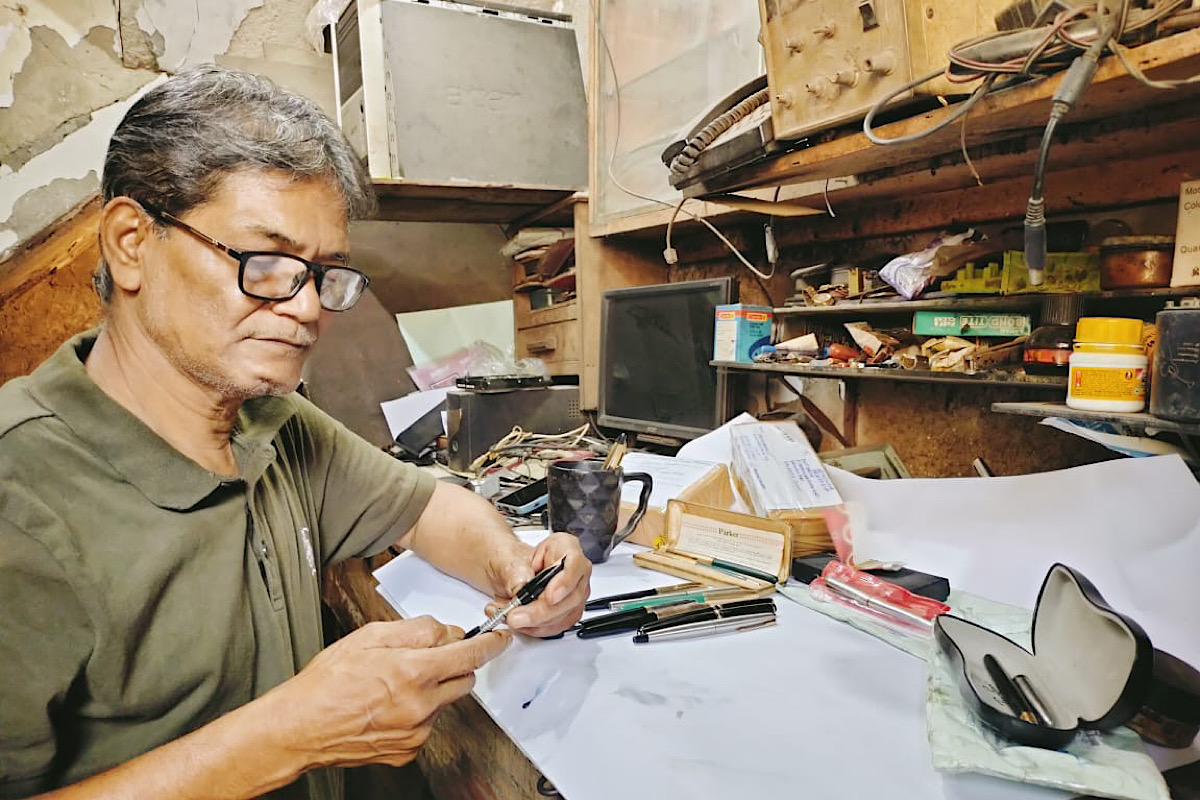Maa Kali: The fierce protector worshipped on Diwali in Bengal
Discover the unique Diwali tradition in Bengal, where Maa Kali, the fierce goddess of protection and power, is worshipped for her role in preserving the cosmos and warding off evil.
The old tradition of buying fountain pens on Poila Baishakh has come back with a bang, with more young people buying fountain pens to celebrate the first day of the Bengali New Year.

(Photo:SNS)
The old tradition of buying fountain pens on Poila Baishakh has come back with a bang, with more young people buying fountain pens to celebrate the first day of the Bengali New Year.
There are three traditions that are followed in Poila Baishakh. The Bengali business houses take their ledgers to Kalighat or Dakshineshwar temple and offer puja to Maa Kali. The second is Halkhata. There was a time when the owners selling gold ornaments, hosiery goods, and saris used to invite their valued customers to their shops in the evening. The guests were offered a glass of sherbet or a cold drink and treated to a plate of sweets. They were presented with a box of sweets and a Bengali calendar. This custom used to be called Halkhata. With the passage of time, this ritual is now observed only in some old shops.
The third custom was to buy a fountain pen. This tradition started disappearing in the late 1990s, when people stopped buying fountain pens and were more interested in using and discarding ballpoint pens and roller pens. There were many companies that used to manufacture fountain pens, like Artex and Diplomat, among others. As the sale of fountain pens fell, the ink manufacturers were badly hit, and most of them shut down their factories.
It is interesting to note that this tradition has returned to Bengal with a bang.
One of the main reasons for the revival of this trend of buying fountain pens is the coming back of Sulekha Ink, the 94-year-old company, which is a household name in Bengal.
In 1930, Mahatma Gandhi requested Satish Chandra Dasgupta to find out people who could manufacture or were manufacturing ink, as one of the prime agendas of the Civil Disobedience movement launched by Gandhi. It was aimed at boycotting foreign goods. In 1932, Dasgupta passed on the formula to manufacture ink to two brothers, Sankaracharya and Nanigopal Moitra. The Moitra brothers set up their factory in Rajshahi, now in Bangladesh. Later, they set up a factory in Jadavpur in 1948. For almost three decades, Sulekha ruled the ink market in India.
In 1977, the country was forced to close the factory due to the militant left trade union movement. The turnaround took place due to the initiative taken by Mr Kaushik Moitra, an engineer from Jadavpur University, now the Managing Director of the company. Besides manufacturing ink, Sulekha started manufacturing fountain pens as well.
“To celebrate India’s 75 years of independence, we brought out a Swadesh variety of ink. We produce ink in different shades. We now produce fountain pens, and youngsters are buying our pens regularly.”
Mr Dilip Basak [in pic], who is often referred to as “the wizard of fountain pen repair,” noted, “Youngsters are coming to me regularly with old pens. The old pens include Waterman, Pelican, Mont Blanc, Swan, Parker, Pilot, Eversharp, and Sheaffer, among others. They are using the pens regularly. They are buying pens during Durga Puja, Saraswati Puja and Poila Baishakh.”
Advertisement
Mr Bodhisattva Mukherjee, a research scholar who buys old pens regularly, said, “We are very active on social media, and when we buy any pen, we exchange details of the pen with our group members. If the pen is good, the members show interest, and this is how the sale of old pens has gone up. For this Poila Baishakh, I have bought a new Lamy. This German pen is very smooth and easy to maintain.”
Kaliketa, a new brand of ink, has hit the market recently. It is a high-quality ink that has attracted young people.
Pen Club, a shop that has come up on College Row, sells both Indian and foreign pens. One gets Waterman, Sheaffer, Mont Blanc, and Cross at the shop. Foreign inks, including Waterman, Seller, and Pilot, are also available here.
Dr Shamik Sengupta, a young doctor, writes prescriptions with a fountain pen. “A patient presented me with a fountain pen. I liked the colour and started using it. As ink is now available on the market, I always write with fountain pens.”
Many schools in Bengal have made the use of fountain pens mandatory, as ballpoint pens often cause writers’ cramps. “Developing ‘writer’s cramp’ at an early age is not good for health. When one grips a ballpoint pen, it hurts to write a letter. But fountain pens are smooth and do not affect the area around the wrist. Writing with a ballpoint pen aggravates with age, and it is very painful. So, we advise students to use fountain pens from an early age,” said Dr Saptarshi Chatterjee, a general physician.
Long live the fountain pen!

Advertisement